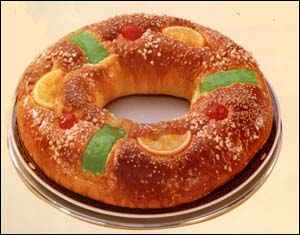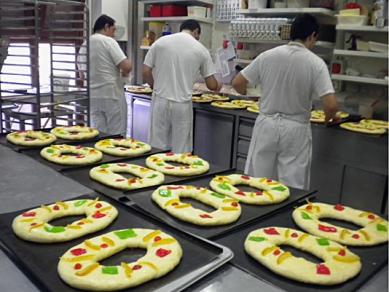
Origin: Spain and other origins.

Roscón de Reyes -twisted roll of kings- is mainly consumed on Three Kings Day in Spain (6th of January, day when the exchange take place). However it's origin it's little related to Christian lore, it's much older and has pagan roots.
In fact roscón de reyes goes back to Roman times, where it was elaborated for Saturnalia, or the slaves' holiday. It was celebrated in mid december to honor the agriculture god, Saturn.
The event commemorated the the end of the darkest period of the year and till the end of the month the "sun holidays" would come, when the sun entered Capricorn, the winter solstice. It meant the end of the labor in the fields. The slaves would be able to rest and recover from a hard season's work
The slaves were given round cakes made of figs, dates and honey. A dry lima bean, which represented prosperity, was hidden in the cakes. The slave who found it in his piece would be free for the day and be treated like a king.
This tradition was absorbed by Christianity when in the 4th century, the church established Three Kings Day. For many years their origin as winter solstice celebration was forgotten
However the custom spread. Many years later in France the celebration was called Le Roi de la Fave (the king of the lima bean). King Louis XV (1710 -1774) had been recently crowned (in fact he was a child) and an Eslavic cook wanted to make him a present on Three Kings Day. The cook prepared roscón de reyes traditional from his land with a surprise in inside: a diamond medallion he purchased with the help of collaborators.
The young king was so delighted with the dessert that he spread it among the French and European aristocracy. However instead of hiding diamond medallions they would use coins.
In Spain it was introduced by Philip V, Louis XV's uncle, and soon it became a highly popular tradition among the nobility. With time the custom seeped from the high classes to the common people. Madrid and Sevilla were the biggest cities to adopt it, and then spread throughout the country and later to Spain's colonies in Latin America.
The lima bean was first substituted by one diamond necklace, then by coins, then by figurines. The current custom is to put a figurine and a lima bean inside the roscón de reyes. The person who finds the figurine will have be lucky during the new year, as the wise kings protect him. The person who finds the lima bean must pay for the dessert.

Ingredients:
Preparation:
If you happen to be visiting Spain during the winter holidays, don't miss out on Roscón de Reyes!